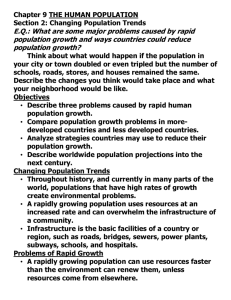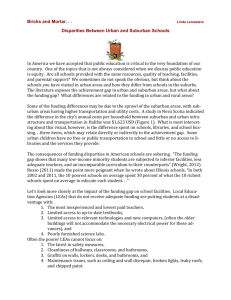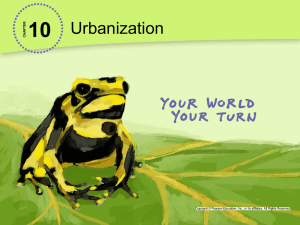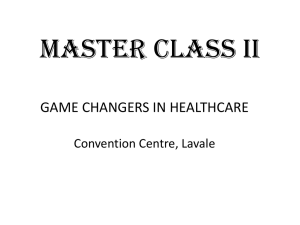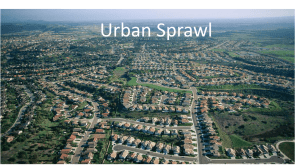APES Population Review - AP Environmental Science
advertisement
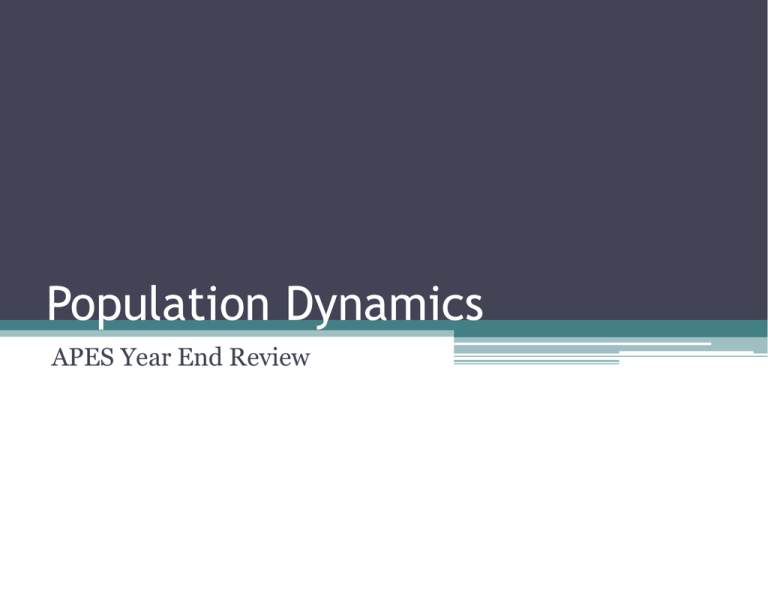
Population Dynamics APES Year End Review Global Population • • • • 2007: 2008: 2009: 2010: 6,625,000,000 (1.2% growth rate) 6,705,000,000 (1.2% growth rate) 6,810,000,000 (1.2% growth rate) 6,818,300,000 (estimated) Population growth affects the environment The IPAT model: I = P x A x T x S • Our total impact (I) on the environment results from the interaction of population (P), affluence (A) and technology (T), with an added sensitivity (S) factor • Population = individuals need space and resources • Affluence = greater per capita resource use • Technology = increased exploitation of resources • Sensitivity = how sensitive an area is to human pressure • Further model refinements include education, laws, ethics Humanity uses 1/3 of all the Earth’s net primary production Population Estimation Methods Mark-Recapture Model Model type Description Lincoln-Peterson Method Closed population Fisheries origin, one marking period Schnabel Method Closed population Fisheries origin, multiple marking periods Jolly-Seber Model Open population Multiple marking periods Polluck’s Robust Design During short periods of Combination of closed and sampling closed open models assumptions, over the longitudinal study treated as open system The Calculations • Given those conditions, estimated population size is: ▫ N = Estimate of total population size ▫ M = Total number of animals captured and marked on the first visit ▫ C = Total number of animals captured on the second visit ▫ R = Number of animals captured on the first visit that were then recaptured on the second visit • N = MC / R Calculating The Growth Rate • Crude Growth Rate formula = Crude Birth Rate – Crude Death Rate = Crude Growth Rate Crude Rates are based on 1,000 individuals • Population Change Formula = (birth rate + immigration rate) – (death rate + emigration rate) = Population Change The CGR for the Earth is roughly 1.2% right now ! Total Fertility Rate (TFR) • The Total Fertility Rate or TFR is an estimate of the average number of children who will be born alive to a woman during her lifetime if she passes through all her childbearing years (ages 15-44) conforming to age-specific fertility rates of a given year. ▫ In simpler terms, it is an estimate of the average number of children a woman will have during her childbearing years. Replacement Level Fertility (RLF) • The Replacement Level Fertility or RLF is the number of children a couple must have to replace them. ▫ The average for a country or the world usually is slightly higher than 2 children per couple (2.1 in the United States and 2.5 in some developing countries) because some children die before reaching their reproductive years. Population Growth • Populations show two types of growth ▫ Exponential J-shaped curve Unlimited Growth Growth is independent of population density ▫ Logistic S-shaped curve Growth affected by environmental stress Growth is not independent of population density Exponential and Logistic Population Growth: J-Curves and S-Curves • Populations grow rapidly with ample resources, but as resources become limited, its growth rate slows and levels off. Figure 8-4 Exponential Growth • N = Noert where ▫ No is the initial population size ▫ r is the rate of growth in decimal form ▫ t is the time (same units as the rate of growth) • If the growth rate of an elephant population is 2%, starting with one male and one female, how many elephants would you have in 250 years? ▫ 297 elephants! Rule of 70 • To determine the doubling time of a population, divide 70 by the percentage of growth. ▫ Uses the exponential growth calculation ▫ If the growth rate is 2%, then, ▫ 70 ÷ 2 = 35 years Carrying Capacity (K) • Exponential curve is not realistic due to carrying capacity of area • Carrying capacity is maximum number of individuals a habitat can support over a given period of time due to environmental resistance (sustainability) Environmental Resistance Ability of populations of a given species to increase in size Abiotic Contributing Factors: Unfavorable light Unfavorable Temperatures Unfavorable chemical environment - nutrients Biotic Contributing Factors: Low reproductive rate Specialized niche Inability to migrate or disperse Inadequate defense mechanisms Inability to cope with adverse conditions K-selected vs. r-selected species Survivorship curves • Type I: late loss, Kstrategists that produce few young and care for them until they reach reproductive age thus reducing juvenile mortality • Type II: constant loss, typically intermediate reproductive strategies with fairly constant mortality throughout all age classes • Type III: r-strategists with many offspring, high infant mortality and high survivorship once a certain size and age Age Structure • The age structure of a population is usually shown graphically • The population is usually divided up into prereproductives, reproductives and postreproductives • The age structure of a population dictates whether is will grow, shrink, or stay the same size Population pyramids are used to show information about the age and gender of people in a specific country. Male Female There is also a high Death Rate. In this country there is a high Birth Rate Population in millions This population pyramid is typical of countries in poorer parts of the world (LEDCs.) Population characteristics Age Structure: Young Populations Can Grow Fast • How fast a population grows or declines depends on its age structure. ▫ Prereproductive age: not mature enough to reproduce. ▫ Reproductive age: those capable of reproduction. ▫ Postreproductive age: those too old to reproduce. The demographic transition Demographic transition = a model of economic and cultural change to explain the declining death and birth rates in industrializing nations Stable preindustrial state of high birth and death rates change to a stable post-industrial state of low birth and death rates As mortality decreases, there is less need for large families Parents invest in quality of life The demographic transition’s four stages Population growth is seen as a temporary phenomenon The International Conference on Population and Development • In 1994 Cairo, Egypt, 179 nations called on all governments to offer universal access to reproductive health care within 20 years ▫ Offer better education and health care and alleviate poverty, disease, and sexism • Despite the success of family planning, recent Republican administrations in the U.S. have declined to fund family-planning efforts ▫ George W. Bush cancelled funding as one of his first acts on becoming U.S. president in 2001 Conclusion The human population is larger than at any time in the past and getting older Populations are still rising, even with decreasing growth rates Most developed nations have passed through the demographic transition Expanding rights for women slows population growth Will the population stop rising through the demographic transition, restrictive governmental intervention, or disease and social conflict caused by overcrowding and competition? Sustainability requires a stabilized population in time to avoid destroying natural systems Urban Growth vs. Urbanization • Urbanization refers to the percentage of people in a country who live in an urban area. • Urban growth refers to the rate of increase of an urban population. Shift from agriculture • One of the reasons for this shift, is that with the technological revolution, less farmers are needed to provide food for the masses. ▫ People move into the cities for work. ▫ The portion of the global population that was considered urban was up to 49% in 2005. Rapid Growth • The greatest rate of growth of these three areas is in the urban areas. ▫ Government is concentrated in the cities. ▫ Industry and commerce centers are in the cities. ▫ Transportation junctions and mass transit is found in urban areas. • What other trend shows rapid growth? 5 Important Trends 1. The proportion of people living in urban areas is increasing. ▫ From 1850 to 2006 the rate of growth has grown from 2% to 47.5% 2. The number of large urban areas is growing. ▫ Megacities or megalopolises Trends, continued 3. Urban population is increasing rapidly in developing countries. ▫ This trend is leading to centers of poverty. 4. Urban growth is slower in developed countries. ▫ Why do you think that is? 5. Poverty is becoming an urban trend as opposed to a rural one. Urban Sprawl • When land is available and affordable, urban areas tend to sprawl outward because: ▫ Federal government loan guarantees stimulated the development of suburbs. ▫ Low-cost gasoline and government funding of highways encourages automobile use. ▫ Tax-laws encourage home ownership. ▫ Most zoning laws separate residential and commercial use of land. ▫ Many urban areas lack proper planning. Sprawl looks like this . . . • Low residential density • Distant Separation of homes, employment, schools, shopping • Lack of a city “center” • Street networks are hard to access The problem here is, • Transportation ▫ people are forced to drive, no mass transit • Pollution ▫ increased pollution from driving cars, road maintenance • Health ▫ promotes physical inactivity and obesity, stress, high blood pressure More problems with sprawl • Land Use ▫ more land is being converted from agricultural to residential, residential land is being proportioned at a high per capita rate • Economics ▫ tax money is spent on new developments and upgrading existing services to meet the demand (where have we seen this?) Typical housing development Fig. 23-17b, p. 565 Cluste r Cluster housing development Pon d Cree k Cluste r Fig. 23-17c, p. 565 Natural Capital Degradation Urban Sprawl Land and Biodiversity Human Health and Aesthetics Loss of cropland Contaminated drinking water Loss of forests and and air grasslands Loss of wetlands Weight gain Loss and fragmentation of wildlife habitats Noise pollution Sky Increased wildlife illumination at roadkill night Increased soil Traffic erosion congestion Water Increased runoff Increased surface water & groundwater pollution Increased use of surface water and groundwater Energy, Air, and Climate Increased energy use & waste Increased air pollution Increased greenhouse gas emissions Decreased storage of surface Enhanced global water and warming groundwater Increased flooding Warmer Decreased natural microclimate sewage treatment (urban heat island effect) Economic Effects Higher taxes Decline of downtown business districts Increased unemployment in central city Loss of tax base in central city Fig. 23-6, p. 553 URBAN RESOURCE AND ENVIRONMENTAL PROBLEMS • Urban areas rarely are sustainable systems. Figure 23-8 URBAN RESOURCE AND ENVIRONMENTAL PROBLEMS • Noise levels of some common sounds. Prolonged exposure to lower noise levels and occasional loud sounds can greatly increase internal stress. Figure 23-9 The Ecocity Concept • Principles of sustainability: ▫ Build cities for people not cars. ▫ Use renewable energy resources. ▫ Use solar-power living machines and wetlands for waste water treatment. ▫ Depend largely on recycled water. ▫ Use energy and matter efficiently. ▫ Prevent pollution and reduce waste. ▫ Reuse and recycle at least 60% of municipal solid waste. The Ecocity Concept ▫ Protect biodiversity by preserving, protecting, and restoring surrounding natural areas. ▫ Promote urban gardens and farmers markets. ▫ Build communities that promote cultural and economic diversity. ▫ Use zoning and other tools to keep the human population and environmentally sustainable levels. Microclimates • A microclimate is the climate of a small area that is different from the area around it. It may be warmer or colder, wetter or drier, or more or less prone to frosts. • Microclimates may be quite small - a protected courtyard next to a building, for example, that is warmer than an exposed field nearby. Or a microclimate may be extensive - a band extending several miles inland from a large body of water that moderates temperatures. Impervious Surfaces & Urban Growth As cities grow and more development occurs, the natural landscape is replaced by roads, buildings, housing developments, and parking lots. The metro Atlanta region has experienced explosive growth over the last 50 years, and, along with it, large amounts of impervious surfaces have replaced the natural landscape. Impervious surfaces can have an effect on local streams, both in water quality and stream flow and flooding characteristics. Impervious surfaces can also affect the temperature of the region. Urban • People often define urban areas, or cities, as land occupied by buildings and other structures used for residences and institutional and industrial sites. ▫ Urban areas often have some form of public transportation, such as buses, subways, or trains and have high population densities. ▫ Buildings are often closer together and built higher than those in suburban or rural areas. ▫ Urban areas are highly populated. Suburban • Suburban areas are those on the outskirts of cities. ▫ Residents of suburban areas often commute to the cities for work. Some suburban areas have commuter trains and buses that shuttle people to and from the cities. ▫ Structures in suburban communities are often lower and farther apart than in cities. ▫ Though they have smaller populations than cities, suburbs offer the same services including schools, health care facilities, and public works. Rural • The 2000 Census showed that 59 million people live in rural areas. These are areas with large amounts of land with significantly lower populations than urban or suburban areas. ▫ Structures are often far apart and some rural communities share hospitals or schools. ▫ Rural areas tend to be far from urban areas. Some examples of rural areas include farmland, woodland forests, plains, deserts, and prairies. Increased Emissions • Elevated emissions of air pollutants and greenhouse gases: Increasing energy demand generally results in greater emissions of air pollutants and greenhouse gas emissions from power plants. Higher air temperatures also promote the formation of ground-level ozone. Quality of Life • Compromised human health and comfort: Warmer days and nights, along with higher air pollution levels, can contribute to general discomfort, respiratory difficulties, heat cramps and exhaustion, non-fatal heat stroke, and heat-related mortality. Water Quality • Impaired water quality: Hot pavement and rooftop surfaces transfer their excess heat to stormwater, which then drains into storm sewers and raises water temperatures as it is released into streams, rivers, ponds, and lakes. Rapid temperature changes can be stressful to aquatic ecosystems.

